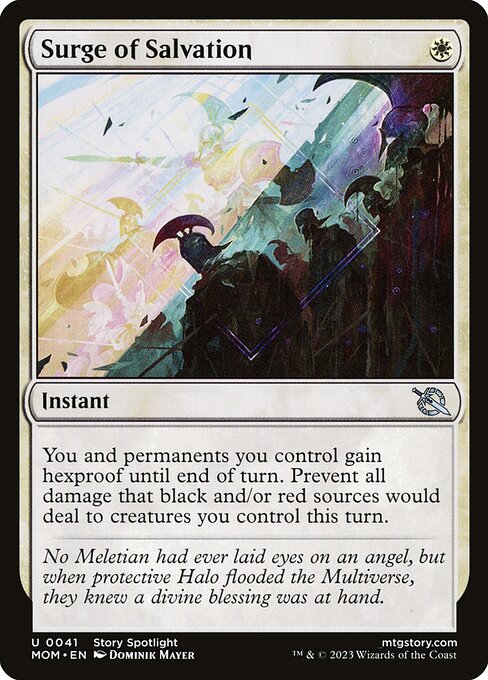
Image courtesy of Scryfall.com
Set-Level Rarity and the White Halo of March of the Machine
Magic: The Gathering design teams constantly choreograph a delicate balance: how often a card appears, how much it enables a given strategy, and how it interacts with the broader color pie. Visualizing set-level rarity balance helps players and collectors read the room before a draft or a constructed league. Surge of Salvation, an uncommon from March of the Machine, provides a clean, instructive example. For a single white mana, you gain a turn of hexproof for yourself and all permanents you control, and you prevent all damage that black and/or red sources would deal to your creatures during that same turn. It’s the kind of spell that can tip the scales in a crowded combat, while staying faithful to white’s tradition of protection and resilience. 🧙♂️🔥
From a rarity standpoint, Surge of Salvation sits in the sweet spot for uncommons: it’s accessible enough to see play in a wide range of formats, yet powerful enough to influence board state meaningfully when drawn at the right moment. Its mana cost—{W} with a low mana value—ensures it slots into white decks without forcing awkward splashes, and its dual-layer effect—protecting you and your board while mitigating a core threat from enemy colors—embodies white’s enduring emphasis on defense, stabilization, and tempo recovery. The card’s text is precise and punchy: hexproof for a turn, plus a broad shield against red/black aggression. That combination is exactly the kind of thoughtful uncommon that designers lean on to maintain balance while still delivering memorable moments. ⚔️
Rarity isn’t a blunt instrument; it’s a design language. A single uncommon can quietly push an archetype from niche to viable, especially when its effect threads through a color’s identity.
To visualize how this plays into set-level balance, picture a colored map where each color—W, U, B, R, G—maps to a band of rarities. The white column is where protection spells and defensive tools cluster, and Surge of Salvation sits high in that column as an uncommon with broad utility. Its ability to shield creatures from two of the most aggressive archetypes—those leaning on black and red—demonstrates white’s resilient core: protect, endure, and navigate through the worst threats until you stabilize the board. March of the Machine adds a multicolor narrative, and the halo motif referenced in the flavor text—No Meletian had ever laid eyes on an angel, but when protective Halo flooded the Multiverse, they knew a divine blessing was at hand—gives the theme a tangible glow. That blend of flavor and function makes rarity a more-than-statistic choice; it’s a signal to players about how forgiving or unforgiving a set will feel as the drafting fruit ripens. 🎨
From a gameplay perspective, Surge of Salvation doubles as both a safety valve and a tempo tool. In a world where players juggle life totals, blockers, and evolving combat tricks, one mana to render your board hexproof and invulnerable to two major threat colors for a turn buys crucial time. It encourages players to lean into white’s strengths—cohesive creature sets, protective auras, and resilient boards—and gives opponents a tangible target: how can you pressure a board that can shimmer into a shield with a single spell? The rarity level helps keep it approachable in casual play while preserving its value in more serious decks, including commander variants where repeated use of protective spells can anchor a game plan for multiple turns. The card’s illustrated art by Dominik Mayer—framed in the 2015 cycle—enlarges the sense of guardianship with crisp lines and a halo-like glow that MD fans instantly recognize. The art, friendly to both new players and long-time enthusiasts, reinforces the tactile joy of guarding a team rather than simply blasting through an opponent. 🎲💎
For collectors, Surge of Salvation’s placement and print status—foil and non-foil—offers a balanced beacon: not the rarest chase card, but one with consistent demand across formats and a reasonable path to investment value. The rarity and print run fit the set’s overall strategy: a wider distribution of impactful uncommons that support diverse white-led builds without inflating prices into stratospheric levels. This is why set-level visualizations matter: they reveal not just card-by-card power, but how the entire ecosystem—draft pick rates, deck-building preferences, and collector interest—harmonizes to shape a format’s memory. 🧙♂️
As you map out your next collection or draft night, also consider how your desk setup can enhance the experience. A neon, non-slip mouse pad, like the Neon Gaming Mouse Pad Non-Slip 9.5x8in Anti-Fray, keeps your focus on the table and in the game. It’s a small touch, but it’s the kind of detail that mirrors the care designers put into balancing a set: practical, reliable, and a little stylish. If you’re curious to grab one, the link below is a clean way to level up your on-table ritual while you analyze the meta. 🔥
Neon Gaming Mouse Pad Non-Slip 9.5x8in Anti-Fray
More from our network
- https://blog.digital-vault.xyz/blog/post/identifying-hot-stars-by-blue-color-index-in-sagittarius/
- https://blog.digital-vault.xyz/blog/post/how-reward-systems-boost-community-engagement/
- https://transparent-paper.shop/blog/post/silent-blue-giant-beyond-the-naked-eye-at-22-kpc/
- https://transparent-paper.shop/blog/post/designing-notion-dashboards-for-entrepreneurs-to-scale/
- https://blog.digital-vault.xyz/blog/post/how-parody-cards-humanize-mtg-featuring-talisman-of-dominance/